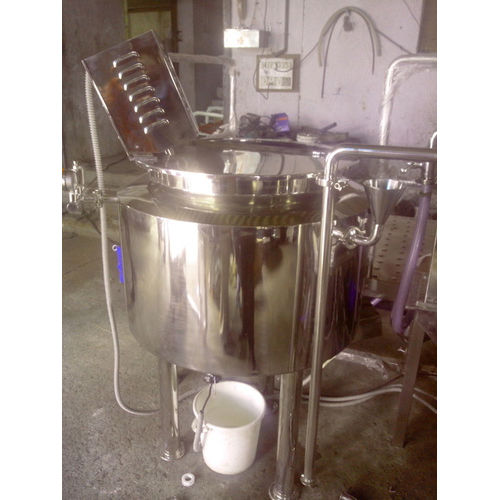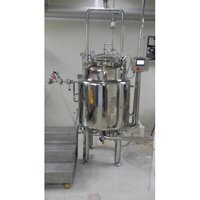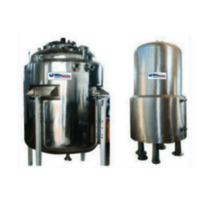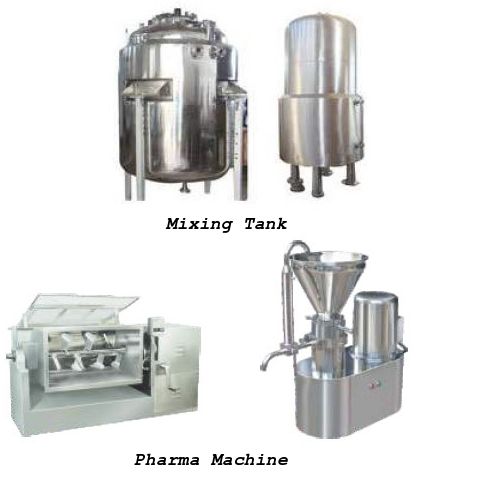Mixing Tank
110000.00 INR/Set
Product Details:
- Usage pharma industry
- Color Silver
- Size Standard
- Product Type Mixing Tank
- Material Stainless Steel
- Shape Round
- Voltage 220-240 Volt (v)
- Click to view more
X
Mixing Tank Price
- 2 Set
- 110000.00 INR/Set
Mixing Tank Specification
- Stainless Steel
- Mixing Tank
- Standard
- Round
- 220-240 Volt (v)
- pharma industry
- Silver
Mixing Tank Trade Information
- 1 Set Per Day
- 1-8 Week
- Standard
- Africa Asia Australia
- All India
- iso certified
Product Description
We are reckoned as a prominent manufacturer, service provider and supplier of Mixing Tank. The offered tank is equipped with a lid with 3/4 operating hinge, slot window and silicon gasket. The tank is notable for its stainless steel made handle and legs. It consists of S.S. 316 ball valve and pipe caster wheel with brake system. Fabricated under the supervision of our skilled professionals, the manufacturing technique of our Pharma Mixing Tank is in sync with the national and international standard.
This machine can also be used within various industrial facilities such as pharmaceuticals, food processing, chemical manufacturing, and many more. It comes with a robust and reliable discharge valve making it easier to extract materials from the processing chamber. Customers can get this sturdy processing tank as per your requirements with a supply capacity of 1 unit per day.
Mixing Tank Salient Features:
- Robust design with high thermal and pressure resistance.
- Suitable for both corrosive and non-corrosive materials.
- Heavy-duty blade assembly to ensure efficient mixing of various types of materials.
- Equipped with baffles for the prevention of preventing vortex formation.
- Easy to access inlet and outlet ports to ensure easy filling and discharge of raw materials.
- Continuous level and pressure monitoring during the mixing operation.
- Reliable safety features to prevent accidents or equipment damage.
- Smooth mirror finish in its interior and exterior surface
- The entry of stirrer is ensured via a lid having Y opening hinge. There is also a slot window and a silicon gasket ring.
- SS 304 is used to make legs and handles
- Caster wheels are provided along with effective brake system
- SS 316 ball valve is available for flushing liquid out. It is fixed at the bottom side of mixing tank.
Get a Closer Look at Mixing Tank :
FAQs : Mixing Tank
What are the common applications of mixing tanks?
There are many different applications where a Mixing tank can be utilized:
- Food and Beverage Industry: Various food ingredients can be mixed with the help of a mixing tank to produce high-quality products such as beverages, dairy products, sauces, dressings, and confectionery items.
- Chemical Manufacturing: In chemical plans mixing tank plays an important role crucial to perform the blending of dissolving solids or diluting concentrated solutions during the production of paints, coatings, adhesives, pharmaceuticals, and fertilizers.
- Water Treatment: In water purification, it is required to mix various types of disinfectants to enhance treatment efficiency, this can be achieved with the help of a mixing tank.
- Pharmaceutical Industry: The mixing tank is involved in the formulation of medicinal suspensions, and various topical medicines such as creams, ointments, or emulsions.
- Cosmetics and Personal Care: This electrically powered machine can also be used to produce lump-free product mixtures that can be used for the preparation of a wide range of cosmetic products.
What safety measures should I consider when working with mixing tanks?
Given below are some of the common points that need to keep in mind while using a mixing tank:
- Use of required personal protective equipment products to avoid various health problems.
- Proper training of the operator and knowledge of the machine is a must.
- The working area needs to be well-ventilated to efficiently remove hazardous fumes, vapors, or dust.
- Use easy-to-handle tools while handling the materials during loading and unloading.
- It is important the machine is incorporated emergency shutdown to quickly turn off the machine in case of emergency situations.
- Keep fire safety equipment within easy-to-reach areas to eliminate the potential risk of fire hazards.
How do I clean and maintain a mixing tank?
To maintain the mixing tank, it is necessary to follow the below-mentioned steps:
- Perform proper cleaning process before or after the cleaning process to maintain the integrity of the product.
- Rinse the mixing chamber with the help of pressurized water jets to efficiently remove light as well as hard impurities.
- Use a soft brush or sponge for cleaning the interior of the internal surfaces of the mixing tank.
- Inspect various kinds of damages which include leaks, cracks, and deterioration of the mixing chamber.
- After complete cleaning, it is required to remove the remaining water from the tank with the help of advanced drying technologies.
What is the typical lifespan of a mixing tank?
Generally, a mixing tank is designed to perform mixing operations for longer periods. There are several factors on which the lifespan of mixing tanks depends which include material used for fabrication, operational conditions, and maintenance cycle. The mixing chamber and other components are typically made up of premium-grade top-grade alloyed steel that gives high rigidity and strength to bear extreme operational conditions which ultimately lead to longer service life.
Can a mixing tank be used for both batch and continuous mixing processes?
A mixing tank is a versatile machine that can be used within various industrial applications for the production of various types of mixtures. It is suitable for batch as well as continuous mixing processes to meet the production needs of your industry.
Tell us about your requirement

Price:
Quantity
Select Unit
- 50
- 100
- 200
- 250
- 500
- 1000+
Additional detail
Mobile number
Email












 Call Me Free
Call Me Free
